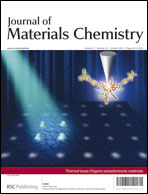Radical self-assembled monolayers on Au(111) formed by the adsorption of closed-shell molecules†
Abstract
Using density-functional theory band-structure calculations, we show how the exothermic adsorption of conjugated closed-shell organic semiconductor molecules on an Au(111) surface can turn them into radicals. For this to happen, we suggest the use of a

- This article is part of the themed collection: Organic optoelectronic materials

 Please wait while we load your content...
Please wait while we load your content...